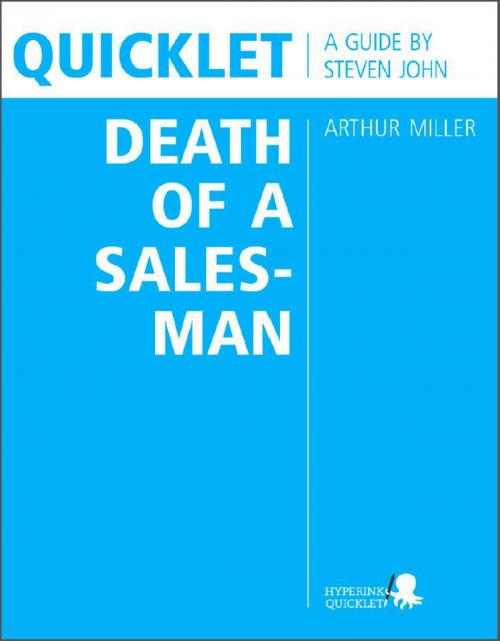Quicklet on Arthur Miller's Death of a Salesman (CliffNotes-like Book Summary and Analysis)
Nonfiction, Reference & Language, Study Aids, Book Notes, Art & Architecture, General Art| Author: | Steven John | ISBN: | 9781614646709 |
| Publisher: | Hyperink | Publication: | July 30, 2012 |
| Imprint: | Hyperink | Language: | English |
| Author: | Steven John |
| ISBN: | 9781614646709 |
| Publisher: | Hyperink |
| Publication: | July 30, 2012 |
| Imprint: | Hyperink |
| Language: | English |
ABOUT THE BOOK
“A diamond is hard and rough to the touch.” - Ben Loman, Death of a Salesman
Why is Arthur Miller’s Death of a Salesman still relevant today? Perhaps this simple question begs the question “IS it still relevant?” To any who ask this, the simple answer is an admonition to read the play. Or see it staged. Or watch any of the myriad cinematic adaptations. (Dustin Hoffman’s portrayal of Willy Loman is arguably a gold standard performance. There are many fine renditions of the role, but the best is surely the one conjured in a careful reader’s mind.)
Before we delve too deeply into the lasting meaning of this play and the still poignant struggles of its characters, let us discuss something held so directly before our faces that we may well look through it and never recognize its paramount importance: the play’s name.
Arthur Miller titled his play -- his first real success -- not simply Death of a Salesman but added the sub-title Certain private conversations in two acts and a requiem. Indeed, death hangs heavy here. The title makes it clear and the word requiem makes it tangible. But let us look, briefly, at the title in surgical detail. Why not “The” Death of a Salesman? Or why not Death of THE salesman? These simple words, these direct object identifiers, would change Willy Loman from the everyman to the man. The genius of Arthur Miller is that Loman manages to be both an everyman and a “real” person -- a character we believe existed, with all his faults, his ticks, his occasional smiles, and his undeniable, unbearable descent.
This is the story of one man and his family as his life circles the drain, the lives of all those who touch his -- an ever smaller circle of people -- following not far behind. It is a story of neurosis and denial, of failure and suffering and of a falsified, gilded past in which the broken characters try to find happiness and solace. Well, that sounds rather bleak.
So why is this such a resonant, potent, and beloved play? Perhaps because it tells a story we all know, and tells it so well. Perhaps it is because as we watch the ever descending arc that is the lives of Willy, Linda, Biff, and Happy Loman, we are made to whisper under our breath “Yes... and there but for the grace of god go I.”
Or maybe it is simply because Arthur Miller was such a fine playwright that he could likely have made a three act about pipe fitting enthralling to all. We shall see as we head deeper into the meat of the play; farther down into the minds -- and psychoses -- of the players. But first, who wrought this jewel?
“And I looked at the pen and I thought, what the hell am I grabbing this for?
EXCERPT FROM THE BOOK
The curtain opens on a small house, several of its walls “removed” so we can see inside it. The lights gradually change to reveal that the house, once quaint and on a lovely spread of land, is now falling apart and is surrounded by tall, drab apartment buildings. The home’s decline mimics that of the head of household, Willy Loman, a man in his 60s and very, very tired.
Loman enters late at night, carrying his heavy valises -- the tools of the trade of a salesman in the 1940s -- and shuffling his tired feet. He is greeted by his wife Linda, a kind, patient but sad woman. The couple talk at length and Willy reveals that he could not complete his trip, intended to take him from their home in New York up to Boston, and has sold nothing that day. He could not complete the trip because his tired mind kept wandering into memories of the past and he found the car drifting about the road, following his meandering thoughts. Loman even thinks he was driving a car the family has not owned for years. He is a man whose best years are past; whose very mind is fading...
...buy the book to continue reading!
ABOUT THE BOOK
“A diamond is hard and rough to the touch.” - Ben Loman, Death of a Salesman
Why is Arthur Miller’s Death of a Salesman still relevant today? Perhaps this simple question begs the question “IS it still relevant?” To any who ask this, the simple answer is an admonition to read the play. Or see it staged. Or watch any of the myriad cinematic adaptations. (Dustin Hoffman’s portrayal of Willy Loman is arguably a gold standard performance. There are many fine renditions of the role, but the best is surely the one conjured in a careful reader’s mind.)
Before we delve too deeply into the lasting meaning of this play and the still poignant struggles of its characters, let us discuss something held so directly before our faces that we may well look through it and never recognize its paramount importance: the play’s name.
Arthur Miller titled his play -- his first real success -- not simply Death of a Salesman but added the sub-title Certain private conversations in two acts and a requiem. Indeed, death hangs heavy here. The title makes it clear and the word requiem makes it tangible. But let us look, briefly, at the title in surgical detail. Why not “The” Death of a Salesman? Or why not Death of THE salesman? These simple words, these direct object identifiers, would change Willy Loman from the everyman to the man. The genius of Arthur Miller is that Loman manages to be both an everyman and a “real” person -- a character we believe existed, with all his faults, his ticks, his occasional smiles, and his undeniable, unbearable descent.
This is the story of one man and his family as his life circles the drain, the lives of all those who touch his -- an ever smaller circle of people -- following not far behind. It is a story of neurosis and denial, of failure and suffering and of a falsified, gilded past in which the broken characters try to find happiness and solace. Well, that sounds rather bleak.
So why is this such a resonant, potent, and beloved play? Perhaps because it tells a story we all know, and tells it so well. Perhaps it is because as we watch the ever descending arc that is the lives of Willy, Linda, Biff, and Happy Loman, we are made to whisper under our breath “Yes... and there but for the grace of god go I.”
Or maybe it is simply because Arthur Miller was such a fine playwright that he could likely have made a three act about pipe fitting enthralling to all. We shall see as we head deeper into the meat of the play; farther down into the minds -- and psychoses -- of the players. But first, who wrought this jewel?
“And I looked at the pen and I thought, what the hell am I grabbing this for?
EXCERPT FROM THE BOOK
The curtain opens on a small house, several of its walls “removed” so we can see inside it. The lights gradually change to reveal that the house, once quaint and on a lovely spread of land, is now falling apart and is surrounded by tall, drab apartment buildings. The home’s decline mimics that of the head of household, Willy Loman, a man in his 60s and very, very tired.
Loman enters late at night, carrying his heavy valises -- the tools of the trade of a salesman in the 1940s -- and shuffling his tired feet. He is greeted by his wife Linda, a kind, patient but sad woman. The couple talk at length and Willy reveals that he could not complete his trip, intended to take him from their home in New York up to Boston, and has sold nothing that day. He could not complete the trip because his tired mind kept wandering into memories of the past and he found the car drifting about the road, following his meandering thoughts. Loman even thinks he was driving a car the family has not owned for years. He is a man whose best years are past; whose very mind is fading...
...buy the book to continue reading!















